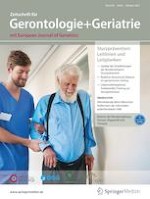07.09.2023 | Themenschwerpunkt
Lebensstilintegriertes funktionelles Training zur Sturzprävention
Wie und warum verändert sich das Gehverhalten?
Erschienen in: Zeitschrift für Gerontologie und Geriatrie | Ausgabe 6/2023
Einloggen, um Zugang zu erhaltenZusammenfassung
Hintergrund und Zielsetzung
Das Lifestyle-integrated-Functional-Exercise(LiFE)-Programm ermöglicht eine Steigerung der körperlichen Aktivität. Bisher ist unklar, wie sich das Aktivitätsmuster hinsichtlich der Dauer der Gehepisoden ändert.
Ziel der Arbeit
Die Veränderungen der kurzen bzw. langen Gehepisoden innerhalb von 6 Monaten sollen untersucht und die Faktoren, die mit diesen Veränderungen im Zusammenhang stehen, sollen überprüft werden.
Material und Methoden
Bizentrische randomisierte Nichtunterlegenheitsstudie mit 309 älteren Erwachsenen (78,7 ± 0,3 Jahre; 73,5 % weiblich), die das LiFE-Programm in Kleingruppen (gLiFE; n = 153) oder individualisiert (LiFE; n = 156) durchführten. Gehepisoden wurden mithilfe des Instruments activPAL 4micro erfasst; es wurde zwischen Gehepisoden mit einer jeweiligen Dauer < 10 s, < 20 s und > 60 s unterschieden. Die Veränderungen der Gehepisoden zwischen Baseline und 6 Monaten wurden überprüft; die Effektstärke (Cohens d) der Veränderungen wurde ermittelt. Einflussfaktoren der Gehepisodenveränderungen wurden mithilfe multipler Regression modelliert.
Ergebnisse
Die Gehepisoden mit den Dauern < 10 s und < 20 s wiesen in beiden Interventionsgruppen signifikante Steigerungen auf, nicht aber jene mit der Dauer > 60 s. Einfluss auf die Veränderung der Gehepisoden zwischen Baseline und Sechsmonatsmessung hatten die Gehdauer und die durchschnittliche Schrittzahl/Tag. Maße der objektiven und subjektiven Funktion lieferten einen sehr geringen, aber signifikanten Beitrag zur Varianzaufklärung der Veränderung.
Diskussion
Das LiFE-Programm entfaltet seine Wirkung vornehmlich als Verhaltensintervention. Kurze Gehepisoden bieten kumuliert ein großes Potenzial zur Steigerung der körperlichen Aktivität. Dies kann insbesondere für Personen in institutionellen Settings oder jene, die sich längeres Gehen (außerhäuslich) nicht mehr zutrauen, von gesundheitsförderlichem Nutzen sein.
Anzeige















